A Canadian pension fund could now be the largest owner of water in the Murray Darling Basin
- Details
- Category: Water
- Created: Monday, 17 February 2020 20:54
- Written by Janek Drevikovsky -
AUSTRALIA’S WATER SUPPLY ON VERGE OF DISASTER AS POPULATION BALLOONS. WHY? Bad government policy to benefit big end of town.
YES … CAAN has had to reduce it to this to spell it out!
WHAT a pack of weak short sighted opportunistic sycophants are our leaders and business community!
HOW MUCH LONGER ARE WE TO PUT UP WITH THIS AUSTRALIA?
MEANWHILE PLEASE START THE CONVERSATION … anywhere … and SHARE!
PSP Investments, a Canadian pension fund, could now be the largest owner of water in the Murray-Darling Basin by ABC Rural - Clint Jasper. 18 February 2020
A Canadian Government-owned pension fund could become one of the largest private owners of water entitlements in the Murray-Darling Basin from today, owning roughly 2 per cent of all its available water rights.
- Tensions over water ownership and trading have been running high, especially in the southern Basin
- A Canadian pension fund has been on a multi-billion dollar buying spree
- The Australian Competition and Consumer Commission is reviewing Australia’s water markets
Canada’s Public Sector Pension Investment Board (PSP Investments) is the pension fund for the country’s armed forces, public servants, police and firefighters. It has been on a multi-billion-dollar buying spree in Australia recently, spending a record amount for a WA dryland cropping operation and water rights in the lower Murray. Now, through its wholly-owned subsidiaries PSP Bidco and Sooke Investments, it is the owner of Webster Limited, Australia’s fourth-oldest company.
The soon-to-be deregistered ASX-listed Webster Limited was already a significant owner of water entitlements, reporting 167,217 megalitres — one megalitre (ML) is 1 million litres — in its portfolio at September last year. PSP’s previous investments in Australian agriculture means that now the deal is complete, the Canadian pension fund holds more than 200,000ML of water in the Murray-Darling Basin. It will use this water to grow walnuts, almonds, cotton, and cereal crops, and is unlikely to ‘speculate’ on water because last year, despite the volume of water Webster owned, it still did not have enough for permanent crops and had to buy water on the expensive spot market.
Adding it up
A breakdown of Webster’s water portfolio provided to investors last year shows high security, general security, and supplementary water rights in the southern Murray-Darling Basin — the Murray and Murrumbidgee Rivers — totalling 133,790ML.

But 81,288ML of water entitlements from those systems will be transferred to KoobaCo, which PSP will only have 49.9 per cent control of, while former Webster chairman Chris Corrigan and director David Fitzsimons will own the remaining stake.
A joint venture between PSP and the Robinson family holdings in the northern Basin, Bengerang, gives it control of around 20,000MLof water there, according to Marsden Jacobs Associates principal Simo Tervonen.
Add the 89,085ML of lower Murray entitlements PSP purchased from Singaporean-based Olam at the end of last year and the total amount of water in the southern Basin owned by PSP grows to about 202,231ML.
“Assuming PSP will have control of water rights in excess of 200,000ML, it would definitely be one of the largest private water owners in the MDB, if not the largest,” Mr Tervonen said.
This year, with general security licences in NSW at zero per cent, Webster told shareholders it had to enter the temporary market to buy enough water to keep its permanent plantations of walnut and almond trees watered.
How much water is that?
According to Mr Tervonen, there were approximately 14,800 gigalitres (GL) — or 14.8 million megalitres — of surface water entitlements on issue across all catchments and entitlement classes in the Murray-Darling Basin.
What is the Murray-Darling Basin Plan again?
Commonwealth and state governments, the largest owners of water in the Basin, hold 21 per cent of surface water entitlements for environmental purposes, leaving 11,700GL for other water licence holders.
Analysis by Marson Jacobs Associates suggested that once groundwater entitlements and conveyance water were removed from the equation, the pool of water available for irrigators was approximately 8,880GL, or 8.88 million megalitres.
“Let’s say a party owns 200,000ML of that pool — that would represent 1.7 per cent of all the consumptive pool,” Mr Tervonen said.
“If we ditch unregulated and conveyance water, 200,000ML [assuming it’s all regulated water] is 2.3 per cent of the consumptive surface water pool.”
Municipal water corporations, as well as irrigation infrastructure operators, are also among the largest holders of water entitlements.
Properties like Cubbie Station have significant water licences, but Mr Tervonen said because they were unsupplemented or overland flow licences, they were very different to licences in other states.
“So basically, on comparable terms, Cubbie’s holdings are only 93,000ML,” he said.
“The ATO foreign ownership register is also based on the nominal volume of the entitlement, not entitlement characteristics such as the volumetric limit.”
Outside the Basin, mining companies like Chichester Metals own around 450GL of water entitlements, and Pilbara Iron owns more then 210GL.
Foreign-owned water
Last year, the Federal Government released the first Register of Foreign Ownership of Water Entitlements revealing that across the country — including all industries, in all states and territories — about 10 per cent of Australia’s water entitlements were foreign owned.
The figure in the Murray-Darling Basin was 9.4 per cent and includes groundwater entitlements, with 21.9 per cent of the northern Basin entitlements foreign owned and 5.5 per cent of southern Basin entitlements held by foreign interests.Non-resident individuals, foreign companies, state-owned enterprises, and any company in which a foreign entity owns 20 per cent or more are considered to be ‘foreign’ under Australian law.
China holds top place with 732GL, with the US (720GL) and the UK (411GL) holding second and third place.
Canada was fourth with 212GL, but PSP’s recent acquisitions could nearly double Canada’s stake in Australian water entitlements.
The ABC spoke with two other people connected to Murray-Darling Basin water markets, and each agreed the ownership of a further 202GL would make the owner one of, if not the largest owner of water in the Basin.
Water ownership debate
Tensions over water ownership and trading have been running high, especially in the southern Basin, this summer.
NSW state Shooters Fishers Farmers MP Helen Dalton has been lobbying hard to introduce laws that would force corporate water owners and any politician who owns water entitlements to publicly declare what they own.
Ms Dalton has declared she owns 1,383ML of high-security water and 3,324 ML of general security water in the Murrumbidgee valley.
Following an 11,000-signature-strong petition submitted to the NSW parliament by Ms Dalton, state politicians will debate the merit of establishing a national water ownership register on February 27.

Former water minister David Littleproud told ABC Rural recently “I think this water market has evolved into something that has gone far beyond what it was first intended to do”.
In information about the PSP deal released to investors and the ASX under the heading “Risks”, Webster said its share price was influenced by “reputational risks, particularly in connection with the water industry”.
The Australian Competition and Consumer Commission is currently undertaking a review of Australia’s water markets.
Webster Limited and PSP Investments were asked to comment on this story, but by the time of publishing neither had responded.
Related articles
- ‘Pure bastardry’: Anger from NSW Government, river council over Queensland water rules
- Water inquiry hears from tourism sector and irrigators in trip down the Murray
- Struggling Darling River farmers strike $30m buyback deal with Government
CHRONOLOGY … MURRAY-DARLING BASIN
- What is the Murray-Darling Basin Plan again?
- Plenty of reasons to be angry at the Murray-Darling plan, but canning it solves none of them
- ‘No water here’: Controversial cotton farm Cubbie Station opens gates to Murray-Darling councillors
- Water market set for shake-up as ACCC ordered to investigate if trade is fair
- Drought and climate change drive high water prices in the Murray-Darling Basin
- Confused by the Murray Darling controversy? Here’s your simple guide
- How taxpayers are funding a huge corporate expansion in the Murray-Darling
- Water Minister wastes no time to deliver on water trade inquiry
- China and US are the biggest investors in Australian water entitlements
- Billions of litres of water ‘missing’ from Murray-Darling Basin, study claims
- The cotton grower, the water minister and the broken meter
- ‘People have to be named’: Scientists say broken Murray-Darling system can be fixed
- Murray-Darling Basin Royal Commission slams authority for ‘maladministration’
- Murray-Darling report lays bare that ‘the system is sick’, say the people it affects
- What will the Murray-Darling Basin Royal Commission reveal?
- Productivity Commission calls out governance failings in Murray-Darling Basin Plan roll-out
- Murray-Darling royal commission won’t cross-examine federal bureaucrats
- Cotton farm execs face court over $20m federal funding ‘fraud’
- How the iconic sites of the Murray-Darling Basin are doing under the plan
- Watch Pumped: Who is benefitting from the Murray-Darling?
- Federal Government and Labor strike deal on future of Murray-Darling Basin Plan
- Advisory group pens unprecedented letter to try save Murray-Darling Basin Plan
- How to kill a river system three times as salty as the sea
- Major Murray-Darling Basin water-saving plan questioned
LIKE CAAN ON FACEBOOK!
https://www.facebook.com/Community-Action-Alliance-for-NSW-744190798994541/?ref=aymt_homepage_panel
SEARCH CAAN WEBSITE for more Reports!
https://caanhousinginequalitywithaussieslockedout.wordpress.com/
WHY the demand for rezoning for Higher Density Housing is creating Tsunami of Sewage Pours …
HOW CAN SYDNEY WATER ADDRESS OVERDEVELOPMENT?
–the situation was worse after heavy rainfall with sewers overflowing into the storm water system
-posing real risks to public health
-resulted in impacts to the water quality (contamination)
It is investigating “water augmentation strategies” to service the booming population …
that means a Water Treatment Plant, with a raw water pump station and treated water pump station …
‘Tsunami of sewage’ pours into Sydney man’s pool after heavy downpour
By Kevin Nguyen

PHOTO: Steve Fender is looking for answers from Sydney Water. (ABC News: Kevin Nguyen)
RELATED STORY: ‘Quite extraordinary’: Cyclone Uesi going ‘right over the top’ of Lord Howe Island
RELATED STORY: Man’s body pulled from river, as storms lash South East Queensland
A man who had a “tsunami of sewage” pour into his swimming pool during the weekend’s heavy rainfall says he is disgusted by the response from Sydney Water.
Key points:
- Sewage poured into Steve Fender’spool, garage, workshop and under his house
- Sydney Water apologised and offered to help with clean-up costs
- A residential tower has been proposed for the nearby metro station

PHOTO: Flooding on Garden Street in North Narrabeen. (ABC News: Dale Drinkwater)
Sydney was battered by torrential rain which caused flash flooding and widespread power outages.
Castle Hill carpenter Steve Fender said stormwater mixed into a sewage line running around his backyard, which then overflowed his 50,000-litre pool on Sunday.
Sydney Water told the ABC this was not supposed to happen.
Mr Fender said the sewage also poured into his workshop, garage and the space under his house.
“I initially thought it was dirty water,” he said.
“It wasn’t until I looked over the fence that I could see it coming out of the sewer pipes.
“It was putrid, it smelt heavily of urine and the next day when it was almost 30 degrees [Celsius] you couldn’t even go out there.”

PHOTO: Steve Fender’s pool overflowed with sewage on Sunday. (Supplied: Steven Fender)
Despite raising concerns it was a serious health hazard, Mr Fender said Sydney Water only agreed to come out today to help with the clean-up and maintenance.
In the interim, Mr Fender drained and dumped about two buckets of chlorine into the pool which helped with the smell.
But a layer of contaminated water remains under his house and a repugnant odour has seeped through the floor and into his living room.
“There’s about 18 houses worth of sewer in that one spot,” he said.
Sydney Water apologised to Mr Fender and offered to assist him with costs associated with uninsured loss and clean-up for the pool and garden.

PHOTO: Steve Fender said the smell was “putrid”. (ABC News: Kevin Nguyen)
*Mr Fender said he was still “absolutely disgusted” by the delayed response andquestioned the viability of housing developments down the road.
A residential tower with up to 300 apartments has been proposed for the nearby metro station.
A Sydney Water spokesperson said it was “working as quickly as possible to respond” to the 6,750 requests for help it had received since the weekend.
*It said crews investigated the overflow near Mr Fender’s Castle Hill home and “found a choke caused by wet wipes had significantly contributed to the overflow experienced by these customers”.
“In Sydney, the wastewater and stormwater systems are separate,” a Sydney Water spokesperson said

.PHOTO: A “tsunami of sewage” dumped into Steve Fender’s pool. (ABC News: Kevin Nguyen)
“However, when it rains, stormwater can enter the wastewater system.”
The regulator said the systems could mix in several ways, including “illegal connections” or faults with wastewater pipes.
Sydney Water said it would roll out new “water and wastewater services to keep pace with rezoning of the land for new housing”.
LIKE CAAN ON FACEBOOK!
https://www.facebook.com/Community-Action-Alliance-for-NSW-744190798994541/?ref=aymt_homepage_panel
SEARCH CAAN WEBSITE for more Reports on sewer failures!
https://caanhousinginequalitywithaussieslockedout.wordpress.com/
Moody’s: “Water stress” Sydney’s biggest threat
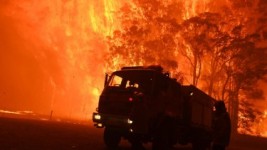
The ongoing cost of the bushfires will have long-lasting impacts on the NSW economy, a report has found.CREDIT:NICK MOIR
FROM the Comments … reference to an article in the Guardian …
Chinese ministry of environment statement that announced in order to prevent the virus from being spread via human excrement and waste water, they will monitor waste water from hospitals.
‘It’s all well and good to drink recycled water until someone forgets to add enough chlorine or whatever. Or someday something doesn’t actually get killed by it or is too small to be filtered out. Then there is the effect of tiny quantities of excreted drugs that form cocktails that you take in over years.’
COMMONSENSE would dictate … wouldn’t it … that rather than precipitate even more major health issues like that of a number of Flu viral illnesses, MERS, SARS and now CoronaVirus that we anticipate and act accordingly … stop with the HT Housing Ponzi, the high immigration and visa manipulation population explosion …
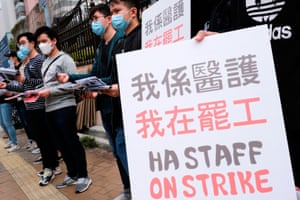
Medical workers hold a strike near Queen Elizabeth Hospital, demanding Hong Kong close its border with China to reduce the coronavirus spreading. Photograph: Tyrone Siu/Reuters
Moody’s: “Water stress” Sydney’s biggest threat
By Leith van Onselen in Australian Economy, Immigration
February 3, 2020 | 6 comments
With Sydney’s water storages shrinking at a rate that is 50% faster than the Millennium Drought, and with storages at just 42.1%:

Moody’s has warned that “water stress” will be the biggest threat facing Sydney by 2030:
The ratings agency Moody’s is warning that NSW faces significant pressures on its budget as it grapples with climate change and increasingly severe droughts and bushfires.
*Moody’s also warns that “water-related stress” will be the most significant issue for Sydney by 2030, with “large scale infrastructure investment” needed to ensure the city has enough water…
“In addition to hindering agricultural production, the prolonged drought is also exacerbating future water stress risk in Greater Sydney – an area that accounts for a growing share of NSW’s overall economy.
“We currently consider water stress to pose the greatest risk to this part of NSW over the longer term.”
*It is important to note that the key reason why Sydney’s water supply is falling faster than the Millennium Drought is because the city’s population has ballooned by one million people (20%) since that drought ended in 2006.
Obviously, with Sydney’s population officially projected to increase by 1,700 people every week over the next half century, all due to mass immigration. And with Sydney’s population projected to almost double to 9.7 million by 2066:

Water shortages will become an increasing problem for Sydney, even before accounting for reduced rainfall and increased evapotranspiration rates from climate change.
This immigration-driven population explosion will necessarily require a battery of energy-hungry desalination plants to be built along Sydney’s coast. And given desalinated water is around four times as expensive as traditional dam water:

These desalination plants will necessarily mean that household water bills will rise dramatically, which will adversely impact lower income households in particular.
Don’t just take my word for it. Modelling by Infrastructure Australia in 2017 projected that household water bills would more than quadruple in real terms because of population growth and climate change, rising from $1,226 in 2017 to $6,000 in 2067. The report also warned that “the impact of these changes on household affordability could be substantial… and could lead to significant hardship”:

Here is another textbook example of how the mass immigration ‘Big Australia’ policy is wrecking living standards for the working class, as well as threatening Australia’s water security.
Cut immigration.
Leith Van Onselen
Leith van Onselen is Chief Economist at the MB Fund and MB Super. Leith has previously worked at the Australian Treasury, Victorian Treasury and Goldman Sachs.
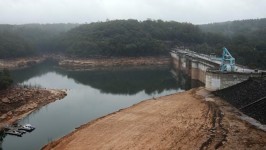
Low water levels at NSW’s Warragamba Dam. Picture: Toby Zerna ‘Water stress a looming test for NSW credit rating: Moody’s’; The Australian
SOURCE: https://www.macrobusiness.com.au/2020/02/moodys-water-stress-is-sydneys-biggest-threat/#comments
UNSW: Sydney’s water supply facing multiple threats
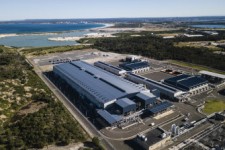
The Sydney Desalination Plant in Kurnell has been reactivated.CREDIT:GETTY

IT isn’t half obvious, is it, what the solution is?
Israel and NSW sign water deal
https://caanhousinginequalitywithaussieslockedout.com/2019/11/22/israel-and-nsw-sign-water-deal/
Australians will have to get used to drinking recycled water
UNSW: Sydney’s water supply facing multiple threats
By Leith van Onselen in Australian Economy
January 29, 2020 | 3 comments
Emma Johnston, Dean of Science at UNSW Sydney, is the latest to warn that Sydney’s water supply is under threat from a combination of population growth, reduced rainfall, greater evaporation, and contamination from bushfires. Therefore, more desalination plants will need to be built:
With water restrictions increasing around NSW and talk about Sydney moving to level three sanctions, people are starting to ask what happens if the city’s water supply becomes critically low?
The prognosis is not good.
*Long-term climate forecasts show the drought continuing for a long time. In addition, our population is increasing and recent per capita water usage rates have actually increased.*
Now there is a new threat: the increased risk, severity and extent of bushfires in Australia as a result of climate change…
An enormous amount of ash and debris has built up in water catchment areas as a result of the fires. Our declining supply of fresh water has inevitably suffered some form of contamination, and this will only get worse when the first decent rains fall.
Compounding matters, the bushfires have destroyed much of the river-side vegetation, which acts as a barrier to erosion, meaning run-off and sedimentation will increase.
This combination of factors has very serious potential consequences for our drinking water…
Big cities, regional centres and small hamlets are all going to need more sources of potable water…
Desalination is expected to become an increasingly critical water source for many coastal populations.
Australia has an enormous coastline and we can afford to do desalination well.
Let’s get real. The main driver of Sydney’s budding water shortage is mass immigration.
Sydney’s population has grown by around 1.3 million people (36%) since the Sydney Olympics, and it is projected to grow by another 4.5 million people over the next 48 years – all due to mass immigration:

This population explosion will necessarily require a battery of desalination plants to be built along Sydney’s coast. And givendesalinated water is around four times as expensive as traditional dam water:

This necessarily means household water bills will rise dramatically, which will adversely impact lower income households in particular.
Indeed, modelling (Deleted?) by Infrastructure Australia in 2017 projected that household water bills would more than quadruple in real terms because of population growth and climate change, rising from $1,226 in 2017 to $6,000 in 2067. *
The report also warned that “the impact of these changes on household affordability could be substantial… and could lead to significant hardship”:

Here is another example of how the mass immigration ‘Big Australia’ policy is wrecking the living standards of the working class.
Australia’s mass immigration policy is now the key threat to Australia’s water security.
Leith Van Onselen
Leith van Onselen is Chief Economist at the MB Fund and MB Super. Leith has previously worked at the Australian Treasury, Victorian Treasury and Goldman Sachs.
SOURCE: https://www.macrobusiness.com.au/2020/01/unsw-sydneys-water-supply-facing-multiple-threats/

NSW Premier Mike Baird, pictured during an April 2016 trip to Israel.
IF you are fed up with the Housing PONZI Scheme and want to change this …. message us through our Facebook link here below for a Campaign Plan!
CAAN FACEBOOK:
https://www.facebook.com/Community-Action-Alliance-for-NSW-744190798994541/?ref=aymt_homepage_panel
WEBSITE:
https://caanhousinginequalitywithaussieslockedout.wordpress.com/
AUSTRALIAs WATER Supply on a Collision Course with POPULATION

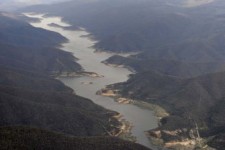
The Thomson Dam, Melbourne’s largest reservoir, is about 56 per cent full.CREDIT:WAYNE TAYLOR
If things were not so crook(ed) in Australia this predicament would be readily solved …
–climate change is reducing inflows into Australia’s water catchments
–looking at an average of 20 per cent reduced reliabilityacross all the catchments
Australia’s water supply on a collision course with population
By Leith van Onselen in Immigration
24 JANUARY 2020
A new study by University of NSW scientists warns that climate change is reducing inflows into Australia’s water catchments, which will cause chronic water shortages as Australia’s population balloons:
“We are looking at an average of 20 per cent reduced reliability in the future across all the catchments considered,” said Ashish Sharma, a professor at UNSW’s School of Civil and Environmental Engineering, and an author of the report.
“While this might not matter a lot up north where you have lower demands compared to inflows, this is pretty serious down south where the demands are high and we are already seeing impacts of the drought,” he said…
Compounding the problem will be the likelihood that cities will lift consumption of water for parks, gardens and other uses.
“Because of that increased demand, you’ll see a greater reduction in reliability [of storage],”Professor Sharma said…
Professor Sharma said that, while authorities could find further ways to reduce demand, at some point a threshold would be crossed and governments would have to make bigger investments…
The mass immigration ‘Big Australia’ policy guarantees chronic water shortages.
According to the Australian Bureau of Statistics’ medium (panel B) projections, Australia’s population will swell by 17.5 million people over the 48 years to 2066,reaching 43 million people:

As shown above, all of Australia’s projected population growth will come from net overseas migration (NOM) – both directly as migrants step off the plane and indirectly as they have children (counted as ‘natural increase’).
The additional 17.5 million people will massively increase water demand at the same time as supply is reduced from lower rainfalland rising evapotranspiration rates due to climate change.
Put simply, the ‘Big Australia’ mass immigration policy is a fundamental threat to Australia’s water security.

The best thing our policy makers could do to safeguard the nation’s water supplies is slash immigration, which is running at around triple the historical average.
Leith Van Onselen
Leith van Onselen is Chief Economist at the MB Fund and MB Super. Leith has previously worked at the Australian Treasury, Victorian Treasury and Goldman Sachs.

A growing water crisis has forced the NSW government to begin planning for an expansion of Sydney’s desalination plant in the next couple of years if significant rain doesn’t fall.
LIKE CAAN ON FACEBOOK: https://www.facebook.com/Community-Action-Alliance-for-NSW-744190798994541/?ref=aymt_homepage_panel
WEBSITE: https://caanhousinginequalitywithaussieslockedout.wordpress.com/
Desalination plants to blow up emissions targets
IT appears the proponents of ‘A Big Australia’have a lot to answer for …

The horror! Desalination plants to blow up emissions targets
By Leith van Onselen in Carbon Economy, Immigration
January 21, 2020 | 18 comments
The New South Wales government recently announced plans to double the capacity of the Sydney desalination plant to 500 million litres a day. A 15 million litre a day plant is also planned for the Hunter region, while one as large as the existing Sydney plant could be built in the Illawarra region if water levels in Sydney dams continue to fall. These desalination plants have sparked concern about a possible lift in greenhouse gas emissions in NSW:
Independent MP Justin Field said other desalination works could add to the demand on the grid…
“Desalination is hugely energy intensive and will produce significant greenhouse gas emissions if powered by coal,” Mr Field said. *
“The new and expanded desalination plants currently being considered in Sydney, the Illawarra and the Hunter could consume as much as 615 gigawatt-hours of electricity a year.”
If all that electricity were to come from the state’s coal-fired power stations, NSW’s annual emissions would increase by some 615,000 tonnes of carbon dioxide-equivalent a year, or the same as adding 250,000 cars on the road, he said…
Let’s cut the bull. Australia will never meet its emissions target while it continues to grow its population by around one million people every three years via mass immigration.
The next chart on Sydney highlights the point. According to the ABS’ medium (Panel B) population projections, Sydney’s population will hit 9.7 million people by 2066, 5.1 million more than what would occur under zero net overseas migration (NOM):

That’s an enormous number of extra people consuming resources and emitting greenhouse gasses.
Moreover, with reduced projected rainfall and rising evapotranspiration rates, Sydney and its surrounding regions would need to build a battery of energy-sucking water desalination plants, which will necessarily raise emissions.
*Remember too that around one quarter of Australia’s emissions come from the construction, operation and maintenance of buildings.
Therefore, as Sydney’s population almost doubles, so too will the number of buildings, driving emissions upwards.
Sure, the Government could attempt to power these desalination plants via renewable energy, but this would very likely shuffle the deck chairs and leave the rest of the state relying on traditional power supplies.
Immigration-fuelled population growth is unambiguously threatening Australia’s ability to meet its Paris Agreement emissions targets, in addition to straining its fragile natural environment.
The current droughts and fires should be a call to arms to stop this ‘Big Australia’ policy madness.
Leith Van Onselen
Leith van Onselen is Chief Economist at the MB Fund and MB Super. Leith has previously worked at the Australian Treasury, Victorian Treasury and Goldman Sachs.

Sydney’s desalination plant is currently powered by renewable energy. What happens to the expansion could have a significant impact on NSW’s emissions and energy. CREDIT:GETTY IMAGES
BURRENDONG DAM: CENTRAL WEST NSW Close to Empty!
-tourism and recreation have dropped off
PERHAPS more development of HYDROPANELS … and recycling (in future) could assist?
‘It should be scary’: Regional NSW dam close to empty
By Janek Drevikovsky
January 15, 2020
Water levels at NSW’s Burrendong Dam, which is three times bigger than Sydney Harbour, have dropped to a critical low of 1.6 per cent, with rain predicted for this weekend unlikely to help.
When full, the dam contains more than a trillion litres of water and supplies local irrigators as well as towns such as Dubbo and Cobar, in the state’s Central West.

Drought affected Lake Burrendong is drying up
The Herald’s Nick Moir captures how dry Lake Burrendong is due to the drought affecting the state.
Just three years ago, the dam was at overflow-levels of 120 per cent, before devastating drought conditions set in.
Now there are fears the dam, which spans the Macquarie River, will run dry and leave towns without a water source. In some areas, that could happen soon: modelling shows Dubbo may run dry by midyear, while for Cobar, regular water sources may fail by September.
“It should be scary for a lot of people,” Cobar council general manager Peter Vlatko said.
“The commitment from the government is that we won’t run out of water. But the difficulty is that the Burrendong is at 1.6 per cent.”

The state government has promised Cobar will receive 80 per cent of its allocated water for 2020, Mr Vlatko said.
But old and faulty infrastructure has compounded problems, with a major pump failure in Hermidale late last year. Dubbo and Cobar residents have been placed on unforgiving water restrictions and miners have been told to save water.
An AGL hydroelectric station that normally uses run-off from the dam has also been taken out of action.
Meanwhile, local officials are scrambling to install additional pumps to extract water pooled below the dam’s usual outlets.
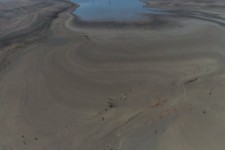
There are also plans to divert water from the Windamere Dam, nearly 200 kilometres away. WaterNSW is meeting landowners and may release up to 25 gigalitres in early February, according to a WaterNSW official.
Under the plan, water would flow via the Cudgegong River and into the Burrendong Dam.
WaterNSW will assess whether the emergency top-up is necessary after this weekend’s forecast rain.
But it’s unlikely the rain will raise the water levels at Burrendong significantly.
“The soil’s so dry at the moment so it acts like a sponge,” University of NSW water scientist Stuart Khan said. “When that happens it takes a significant amount of rainfall to generate run-off.
“If we have 40 or 50 mm [of rain] then we might expect some good run-off. But 50 mm is not going to fill the lake. I think you need something like 50 mm to even start generating run-off.”
WaterNSW agreed that “significant” rainfall would be required to make a difference to the dam’s levels.
In its current state, Burrendong Dam looks unrecognisable compared with during flood years. In 1990 and again in 2010, deluges filled the dam to overflowing, with the catchment at more than 150 per cent capacity.
Wildlife, included kangaroos, were stranded, requiring a rescue operation by boat.

The last year of flooding was 2016, after which levels began to plummet. Now, with dam levels so low, tourism and recreation have dropped off in the area. Codey Swadling, from outside Orange, grew up waterskiing on the dam.
RELATED ARTICLE
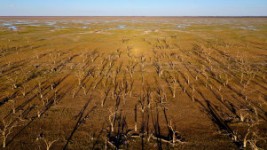
EXPLAINER
EXTREME WEATHER
How bad is this drought and is it caused by climate change?
“It’s a significant loss for the people who regularly use the water for water sports,” he said. “[But there’s] a far more severe impact on the communities and business that rely on … these hobbyists.”
WaterNSW said “historic” dry conditions were responsible for the nearly empty dam levels.
Mr Swadling agreed he had never seen the dam in this condition.
“The landscape has been devastated. I can’t recall such a prolonged period of emptiness.”

CAAN FACEBOOK:
https://www.facebook.com/Community-Action-Alliance-for-NSW-744190798994541/?ref=aymt_homepage_panel
WEBSITE:
https://caanhousinginequalitywithaussieslockedout.wordpress.com/
How Western Sydney is tackling the mysterious ‘heat island’ effect behind rising temperatures
WHAT if the actual design of your city is causing the thermometer to spike?
-higher density perhaps? With trees chopped for more housing
The biggest cause of the ‘heat island effect’ … hard surfaces of buildings, roads, footpaths, roofs
-some residents call for trees to be removed
But people are getting there — it’s about generational change.
THE science is unequivocal — heat is a problem.
-the urban heat island effect has been called inadvertent climate change
Climate Statistics for Australian Locations … Sydney Observatory
Photo: Heat Island from Parramatta Council
How Western Sydney is tackling the mysterious ‘heat island’ effect behind rising temperatures
Updated 1 Mar 2018

RELATED STORY: Heatwaves are Australia’s deadliest natural hazard and many are unprepared
On a hot summer’s day in Sydney, you only need to drive half an hour west before the mercury starts to noticeably jump.
Penrith was the hottest place on the planet at 47.3 degrees on January 7 this year. In Sydney, the temperature reached a comparatively meagre 44 degrees.
It’s a pretty standard story — the further you are from the ocean, the higher the temperature.
Rising global temperatures are one thing, but what if the actual design of your city is causing the thermometer to spike?
And while anyone close to the ocean can easily flock to the beaches on those hot sweaty days, people living out west have to find other ways to stay cool — which can often be expensive.
Western Sydney councils are banding together to tackle the growing heat problem, but it’s not as straightforward as you’d think.
How do you make a city cooler?
The Western Sydney Organisation of Councils (WSROC) represents eight councilstrying to tackle climate change and the urban heat problem.
*It’s particularly pertinent because the State Government’s policy is to move another million residents to Western Sydney in the next 20 years.
*They want to build a new airport and the world’s largest incinerator — all of which that means more roads and more roofs.
Stephen Bali, mayor of Blacktown and president of WSROC, worries it will only get worse.
“There is a change in the climate between eastern seaboard versus Western Sydney,” he said.
“There’s also pollution effects, because we don’t get those winds that often clear the air.
“And we live in a basin so pollution is higher and hence the actual impact on people is higher.
“Cardiovascular disease, higher respiratory illnesses, every cancer rate that you can look at is higher in Western Sydney than on the eastern seaboard.“

One simple idea is to just plant a lot of trees.Trees make an area cooler. But there’s a problem.
“Generally if you go to someone and say you want a medium to tall tree, people will say no,” Mr Bali said.
“Because they’re scared about — and quite rightly — the impact on the footpath and the road and amenities.”
Even that plan would take time, with a tree taking about 20 years to have any significant effect on an area.
“We have the issue right here and right now that we have to deal with,” Mr Bali said.
He said people generally did not want trees either in their front yards or around their house.

“You look at the number of complaints that councils get [which] are people actually asking for trees to be cut down,” he said.
So even trees are not as simple a solution as you would think.
Thinking about the future
But people are getting there — it’s about generational change.
Councils are spacing out streets, they’re using reflective colours, planting trees, using heat sensors, holding design competitions, installing water features — these are just some of the things the west are doing to fix the city.
Western Sydney programs to combat urban heat:
- Cool Parramatta
- Turn Down the Heat
- Blacktown’s Cool Streets program
- Penrith’s Cooling the City Strategy
“You don’t have to have to have an argument about global climate change or anything,” Mr Bali said.
*“Manmade climate change in the Sydney basin will have an effect, there is no question about that. *
“So essentially how do we accommodate our health systems to recognise that there are these issues and apart from just building hospitals, which is an end product … we want to avert the illness.”
What is the urban heat island effect?
The urban heat island effect is caused when a metropolitan area is significantly warmer than surrounding areas due to human activity.
The biggest cause of it is hard surfaces, like roads, footpaths, roofs, as well as buildings.
They absorb the sun’s heat to send it rippling throughout the surrounding areas.

Jonathan Fox, a researcher at the UNSW in the faculty of built environment, looks at how to design buildings of the future.
He said the science is unequivocal — heat is a problem.
“We live in an urbanising world so more people live in cities, the cities are getting bigger and cities are getting hotter,” he said.
“And then we have a consequence of urbanisation, which is commonly referred to as the urban heat island effect.”
If you’re in a city today and you’re feeling hot, look around and you’ll start to notice all the things that make the heat worse, which add to the urban heat island effect.
These are things like dark concrete, no trees for shade, houses with dark roofs, endless paved roads as far as the eye can see.
“[The urban heat island effect] has been called inadvertent climate change, and there’s no doubt that the way cities have been constructed in the past, without knowledge of the climate effects of design, have exacerbated the overheating problem in cities,” Mr Fox said.
Simple solutions, like lighter roofs

One city concerned about the rising heat is Parramatta.
The manager of Parramatta’s city strategy team, Geoff King, said when it gets hot in the Western suburbs of Sydney, it’s “scorching”.
“The data tells us that nobody goes out in the street, so people stay in their buildings,” he said.
“Once it gets over 35 degrees you get a major drop in pedestrian traffic. So I’d describe it as they scuttle from air conditioning to air conditioning.”
And when it heats up people stop going outside, they stop exercising and they stop buying things, which is bad for the economy.
Major infrastructure can deteriorate, and worst of all, people can get sick and die.
More people have died from heat waves in the past 100 years than every other natural disaster combined.
So Parramatta Council has a few different projects underway aimed at dealing with heat.

One of them is pretty simple. Lodged in the branches of different tree species are 20 temperature sensors — tiny little pieces of plastic stuck to tree limbs hidden from view.
It’s called Smart City project and is being run in cooperation with Parramatta parks and reserves workers.
“So it’s a really low tech, really flexible and easy way for us to monitor the temperature in the park under each of the tree species,” Mr King said.
“It basically logs temperature regularly for three months until the battery runs out and then it just becomes a USB stick.”
The council also have two water parks in operation — basically playgrounds covered in giant sprinklers.
Along with simple projects such as those, Parramatta Council regularly run design competitions for architects, asking them to rethink the design of buildings — like including awnings, reorienting the building’s outlook, and changing the materials

One of the questions Mr King raises is the trend of having dark roofs on houses and buildings.
“It’s an interesting question — why do we like dark roofs?” he said.
“I think it’s aesthetics related to what we know, and I’m going to hazard a guess here, I think the original colonial buildings that had Welsh slate on them came out as ballast in the ships.
“They were the top class, they were the top houses, and so they had black roofs.
“And I think over time we’ve associated black roofs with a quality finish and a high-class building, but in an Australian climate.
“So we’ve done a lot of research into roofs being a really simple way, the colour of roofs being a really simple way of reducing the energy load on your building.”
Mr King said the corrugated iron roofs found on more and more western Sydney homes work well, with the light silver colouring capable of reflecting the sun, instead of soaking it up.
CAAN FACEBOOK: https://www.facebook.com/Community-Action-Alliance-for-NSW-744190798994541/?ref=aymt_homepage_panel
WEBSITE: https://caanhousinginequalitywithaussieslockedout.wordpress.com/
Lost Country: Aboriginal Flags Have Begun Flying At Half Mast Around Australia
“Aboriginal and non-Indigenous Australians all understand that by lowering a flag we acknowledge that something has died or that something is dying. It is a symbol of mourning. There are so many people who are feeling anguish.”
Lost Country: Aboriginal Flags Have Begun Flying At Half Mast Around Australia
By Chris Graham on January 17, 2020 Aboriginal Affairs
DON’T MISS ANYTHING! ONE CLICK TO GET NEW MATILDA DELIVERED DIRECT TO YOUR INBOX, FREE!
An Aboriginal woman from Victoria is hoping that First Nations people and organisations around the nation will join her university in flying Indigenous flags at half mast, to acknowledge the grief Aboriginal people are feeling at the destruction of Country from Australia’s ongoing bushfire crisis.
Associate Professor Gabrielle Fletcher is a Gundungurra woman from the Blue Mountains of New South Wales. She’s also a Professor in Indigenous Studies and the Director of the Institute for Koorie Education at Deakin University in Melbourne.
“To lose Country, in this way, is a particular grief for Aboriginal and Torres Strait Islander people. It’s a messy grief,” Associate Professor Fletcher told New Matilda.
“It’s more in sorrow than anger, it’s mourning. You could say it’s ‘Sorry business’ in a way.
“As a collective, this symbolic gesture may provide somewhere for all Australians to leave parts of this despair.
“It’s also a reflection of the immense grief of guilt where we feel a kind of irresponsible helplessness – our sense of the abandonment of our cultural obligations to Care for Country.”
Deakin University is already flying the Aboriginal flag at half mast today, after a request from Associate Professor Fletcher this week to the Vice-Chancellor, Professor Iain Martin, with the gesture receiving “overwhelming” support from Deakin faculty and students.
Professor Fletcher is hoping it might spread across the nation, and that “these lowered symbolic fabrics become the message sticks for urgent change”.
“Aboriginal and non-Indigenous Australians all understand that by lowering a flag we acknowledge that something has died or that something is dying. It is a symbol of mourning. There are so many people who are feeling anguish.”
Assoc Prof Fletcher said the scale of the loss felt by First Nations people was enormous, and it wasn’t just restricted to the land and its animals.
“Country moves beyond landscape, allotment, vista or wildlife as stand-alone components. It is also place, Ancestors, shadows, mist, warble, maps and vapour,” she said.
“When Aboriginal People lose Country to this scale we lose Knowledge, Ways, Forms, Spirit and Healing – these are a complex interconnection, where everything has its place to teach, feel, show and speak.
“With each loss we slip further away from understanding who we are, and how we fit – this is the ultimate death in many respects.”
Assoc Prof Fletcher acknowledged there were some positives to come out of the fire crisis, beyond waking people up to the realities our nation faces.
“People are starting to recognise and acknowledge the validity and value of Indigenous Knowledges, and ways of knowing, being and doing. It’s been an uncomfortable discovery for some.”
Assoc Prof Fletcher hopes that other organisations follow suit and lower their Aboriginal flags in the aftermath of the bushfire emergency.
“I think this action symbolically describes the collective realisation that we’ve lost so much more than what can be seen and is a true wake-up call.” Professor Fletcher said.
“On behalf of the Institute of Koorie Education, I thank Deakin Vice-Chancellor Professor Iain Martin for his support in this unprecedented gesture.”
If you’re supporting this story on social media, please use the hashtag: #HalfMastForMyCountry
BE PART OF THE SOLUTION: WE NEED YOUR HELP TO KEEP NEW MATILDA ALIVE. Click here to chip in through Paypal, or you can click here to access our GoFundMe campaign.Sharing is caring
Donate To New Matilda
New Matilda is a small, independent media outlet. We survive through reader contributions, and never losing a lawsuit. If you got something from this article, giving something back helps us to continue speaking truth to power. Every little bit counts. TAGS: chris grahamFacebookTwitterGoogle+LinkedInmorePinterestTumblrEmail
Chris Graham is the publisher and editor of New Matilda. He is the former founding managing editor of the National Indigenous Times and Tracker magazine. Chris has won a Walkley Award, a Walkley High Commendation and two Human Rights Awards for his reporting. He lives in Brisbane and splits his time between Stradbroke Island, where New Matilda is based, and the mainland.
80% of BLUE MOUNTAINS and 50% of GONDWANA Rainforests burn in Bushfires!
IT would appear government focus has been in all the wrong places … of GROWTH … and ever more ECONOMIC GROWTH …
‘It’s heart-wrenching’: 80% of Blue Mountains and 50% of Gondwana rainforests burn in bushfires
Guardian Australia analysis reveals the frightening amount of world heritage area burned in Australia’s ongoing fire crisis
Supported by Lisa Cox and Nick Evershed
FRIDAY 17 JANUARY 2020
At least 80% of the Blue Mountains world heritage area and more than 50% of the Gondwana world heritage rainforests have burned in Australia’s ongoing bushfire crisis.
The scale of the disaster is such that it could affect the diversity of eucalypts for which the Blue Mountains world heritage area is recognised, said John Merson, the executive director of the Blue Mountains World Heritage Institute.
The data is based on a Guardian Australia analysis of areas burned in New South Wales and Queensland and was confirmed by the NSW government.
Guardian Australia reported in December that 20% of the Blue Mountains world heritage area had been affected by fire in the early months of the crisis.
Four times that amount has now burned in what Merson said were fires of a scale that “has never happened before”.
“This is totally, totally unique. As everybody keeps saying, it’s unprecedented,” he said.
The Blue Mountains world heritage areacovers one million hectares of national park and bushland and is dominated by temperate eucalypt forest.
The area is renowned for the diversity of its vegetation and is home to about a third of the world’s eucalypt species.
While most are fire-adapted and can regenerate, many of the species depend on long intervals between fires, Merson said.
“We had a very large fire in 2013. It’s only six years after that,” he said.
“The eucalypts can be very badly reduced in diversity if fires come through in too short and intense intervals. Their numbers will virtually collapse.”
He said the full impact on tree species and wildlife would not be known until more assessments were done as fire grounds became accessible.
But there are concerns about the effect on breeding and feeding habitats for species including the spotted-tail quoll and the brush-tailed rock-wallaby.
The fires have also burnt swamp communitiesthat release water slowly and are important water resources. They flow into streams that feed into Sydney’s water supply and provide water for wildlife.
It was revealed this week that a rescue mission by NSW fire crews was able to save the only known natural grove of Wollemi pines, so-called “dinosaur trees” that fossil records show existed up to 200m years ago.
Merson said the fires had entered areas that had not burnt previously and the need for the rescue mission was indicative of the intensity of the fires in the region.
Play Video0:55 Prehistoric Wollemi pines saved by firefighters from Australia’s bushfires – video
“This is climate change in its most fundamental form,” he said.
“This is right in our face. We’re living it.”
Further north, the fires have devastated parts of the Gondwana rainforest world heritage area, a collection of reserves of subtropical rainforest that span 366,500 hectares across NSW and Queensland.
Guardian Australia used newly released data which combines all burned areas in NSW and Queensland since 1 July 2019, and calculated the area of overlap with world heritage areas.
This analysis shows 53% of the Gondwana rainforest area has burned.
Guardian Australia spoke to Mark Graham, an ecologist with the Nature Conservation Council of NSW, in December.
Graham is based in the Bellinger Valley near some of these fires.
He said since December there had been “significant, additional fire in areas that hadn’t burned” in Barrington Tops.
“The Tweed Valley is the only significant area of Gondwana that hasn’t experienced any fire,” Graham said.
“Everywhere else has. It’s taken a massive hit.
“It’s heart-wrenching. It’s disturbing. It’s frightening.”
Graham said his area had experienced some rain in recent weeks but there were now concerns that sediment washed into the Bellinger River has affected the food sources for the critically endangered Bellinger River snapping turtle.
A spokesman for the NSW Department of Planning, Industry and Environment said understanding the impact of the fires on both world heritage areas was a priority.
Record-breaking 4.9m hectares of land burned in NSW this bushfire season
“Analysis will improve as the forests becomes safe to enter and the smoke clears, enabling accurate satellite and aerial imagery to help guide our assessment and on work on ground,” he said.
He said both regions contained a mixture of forest types, some of which was adapted for fire, but others that were more sensitive to fire, such as dense rainforest.
Jess Abrahams, the nature campaigner for the Australian Conservation Foundation, said climate change was hitting Australia’s world heritage areas “very hard”.
“We have witnessed consecutive years of devastating coral bleaching on the Great Barrier Reef, while global heating has been described as a catastrophic risk to the Wet Tropics and Shark Bay world heritage areas,” he said.
“It’s really upsetting to see how much of the Blue Mountains world heritage area has been burnt.
“This is a place many Australians know and love. It has significant Indigenous cultural values and is home to a number of rare and threatened species.”
VIEW SOURCE LINK FOR VIDEOS AND GRAPHS:
Environmental investigations reporting supported by the Limb Family Foundation
 Explainer: what are the underlying causes of Australia’s shocking bushfire season?
Explainer: what are the underlying causes of Australia’s shocking bushfire season?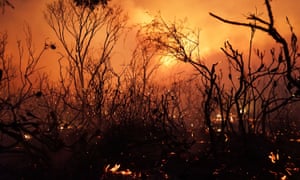 Factcheck: are national parks ‘locked up’ and more vulnerable to bushfires?
Factcheck: are national parks ‘locked up’ and more vulnerable to bushfires?  ‘Silent death’: Australia’s bushfires push countless species to extinction
‘Silent death’: Australia’s bushfires push countless species to extinction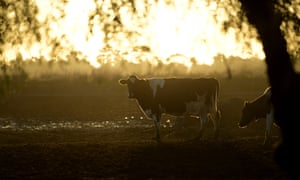 Published:23 Dec 2019
Published:23 Dec 2019
LIKE CAAN ON FACEBOOK: https://www.facebook.com/Community-Action-Alliance-for-NSW-744190798994541/?ref=aymt_homepage_panel
SEARCH WEBSITE TO FIND MORE! https://caanhousinginequalitywithaussieslockedout.wordpress.com/
